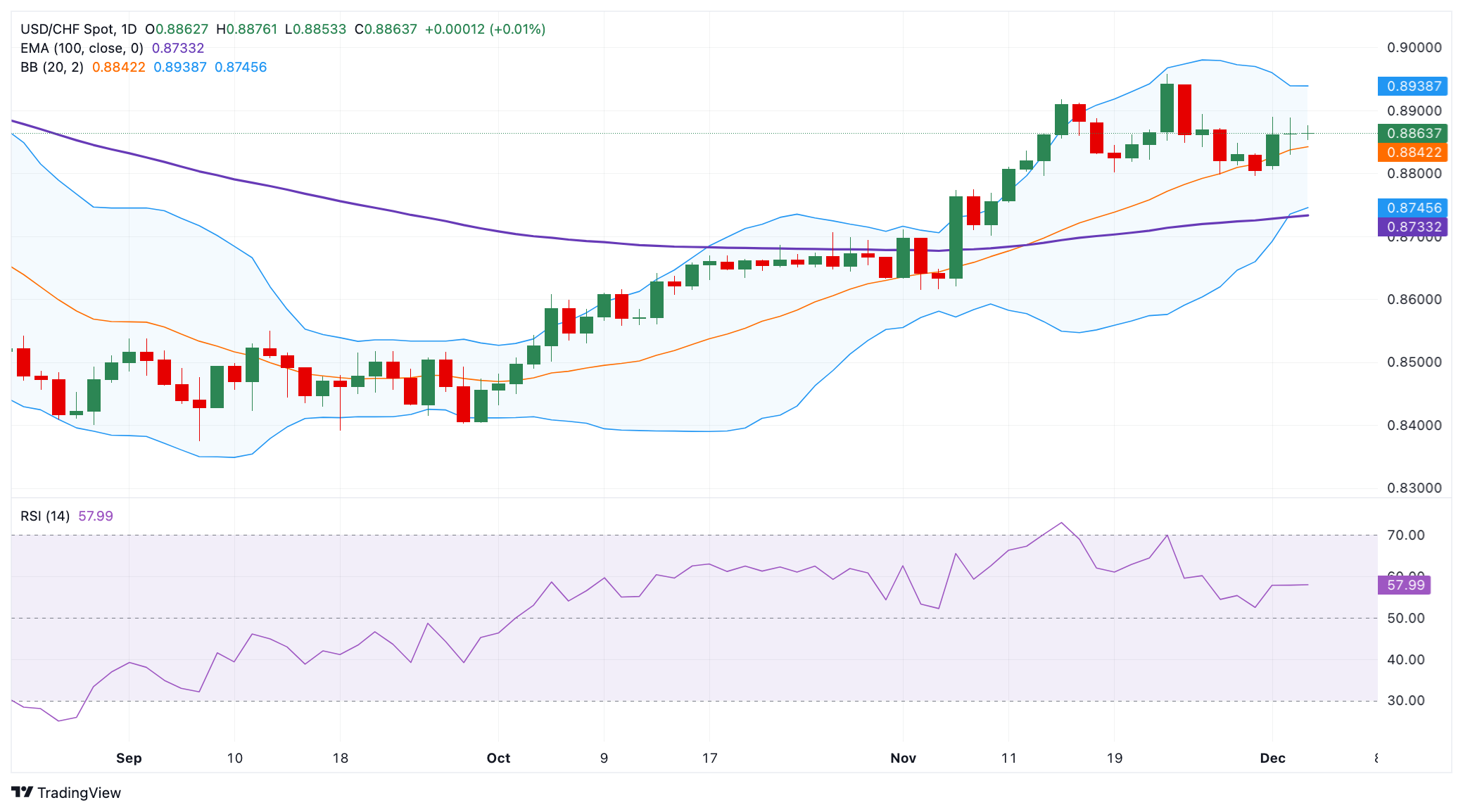- Analytics
- News and Tools
- Market News
- USD/CHF Price Forecast: Remains constructive above 0.8850, eyes on Fed’s Powell speech
USD/CHF Price Forecast: Remains constructive above 0.8850, eyes on Fed’s Powell speech
- USD/CHF holds steady near 0.8860 in Wednesday’s early European session.
- The constructive outlook of the pair remains in play above the 100-day EMA with the bullish RSI indicator.
- The first upside barrier emerges at 0.8938; the initial support level is located at the 0.8800-0.8795 region.
The USD/CHF pair flat lines around 0.8860 on Wednesday during the early European trading hours. Traders prefer to wait on the sidelines ahead of the key US events this week. The US Federal Reserve Chair Jerome Powell is set to speak later on Wednesday. On Friday, the attention will shift to the US November employment data, including Nonfarm Payrolls (NFP), Unemployment Rate, and Average Hourly Earnings data.
According to the daily chart, USD/CHF keeps a bullish vibe at present as the price is well-supported above the key 100-day Exponential Moving Average (EMA). Furthermore, the upward momentum is supported by the 14-day Relative Strength Index (RSI), which is located above the midline near 58.00, suggesting that the path of least resistance is to the upside.
The upper boundary of the Bollinger Band at 0.8938 acts as an immediate resistance level for USD/CHF. Any follow-through buying above this level could expose 0.8957, the high of November 22. The 0.9000 psychological level appears to be a tough nut to crack for USD bulls.
On the other hand, the first downside target of the pair emerges in the 0.8800-0.8795 zone, representing the round mark and the low of November 29. Extended losses below the mentioned level could pave the way to the 0.8745-0.8735 regions, portraying the lower limit of the Bollinger Band and the 100-day EMA.
USD/CHF daily chart
Swiss Franc FAQs
The Swiss Franc (CHF) is Switzerland’s official currency. It is among the top ten most traded currencies globally, reaching volumes that well exceed the size of the Swiss economy. Its value is determined by the broad market sentiment, the country’s economic health or action taken by the Swiss National Bank (SNB), among other factors. Between 2011 and 2015, the Swiss Franc was pegged to the Euro (EUR). The peg was abruptly removed, resulting in a more than 20% increase in the Franc’s value, causing a turmoil in markets. Even though the peg isn’t in force anymore, CHF fortunes tend to be highly correlated with the Euro ones due to the high dependency of the Swiss economy on the neighboring Eurozone.
The Swiss Franc (CHF) is considered a safe-haven asset, or a currency that investors tend to buy in times of market stress. This is due to the perceived status of Switzerland in the world: a stable economy, a strong export sector, big central bank reserves or a longstanding political stance towards neutrality in global conflicts make the country’s currency a good choice for investors fleeing from risks. Turbulent times are likely to strengthen CHF value against other currencies that are seen as more risky to invest in.
The Swiss National Bank (SNB) meets four times a year – once every quarter, less than other major central banks – to decide on monetary policy. The bank aims for an annual inflation rate of less than 2%. When inflation is above target or forecasted to be above target in the foreseeable future, the bank will attempt to tame price growth by raising its policy rate. Higher interest rates are generally positive for the Swiss Franc (CHF) as they lead to higher yields, making the country a more attractive place for investors. On the contrary, lower interest rates tend to weaken CHF.
Macroeconomic data releases in Switzerland are key to assessing the state of the economy and can impact the Swiss Franc’s (CHF) valuation. The Swiss economy is broadly stable, but any sudden change in economic growth, inflation, current account or the central bank’s currency reserves have the potential to trigger moves in CHF. Generally, high economic growth, low unemployment and high confidence are good for CHF. Conversely, if economic data points to weakening momentum, CHF is likely to depreciate.
As a small and open economy, Switzerland is heavily dependent on the health of the neighboring Eurozone economies. The broader European Union is Switzerland’s main economic partner and a key political ally, so macroeconomic and monetary policy stability in the Eurozone is essential for Switzerland and, thus, for the Swiss Franc (CHF). With such dependency, some models suggest that the correlation between the fortunes of the Euro (EUR) and the CHF is more than 90%, or close to perfect.
© 2000-2025. All rights reserved.
This site is managed by Teletrade D.J. LLC 2351 LLC 2022 (Euro House, Richmond Hill Road, Kingstown, VC0100, St. Vincent and the Grenadines).
The information on this website is for informational purposes only and does not constitute any investment advice.
The company does not serve or provide services to customers who are residents of the US, Canada, Iran, The Democratic People's Republic of Korea, Yemen and FATF blacklisted countries.
Making transactions on financial markets with marginal financial instruments opens up wide possibilities and allows investors who are willing to take risks to earn high profits, carrying a potentially high risk of losses at the same time. Therefore you should responsibly approach the issue of choosing the appropriate investment strategy, taking the available resources into account, before starting trading.
Use of the information: full or partial use of materials from this website must always be referenced to TeleTrade as the source of information. Use of the materials on the Internet must be accompanied by a hyperlink to teletrade.org. Automatic import of materials and information from this website is prohibited.
Please contact our PR department if you have any questions or need assistance at pr@teletrade.global.
















